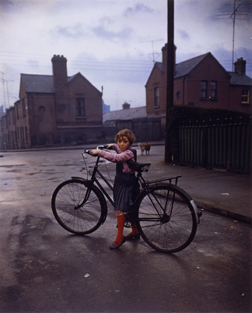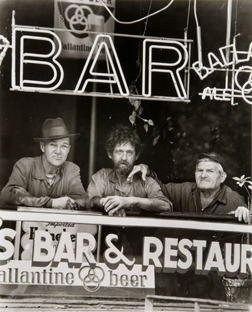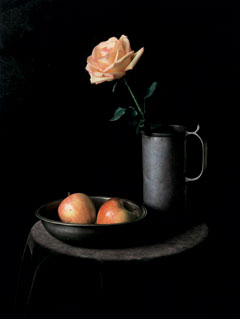Evelyn Hofer
Photographs by Evelyn Hofer
Statement
"What fascinates me concerning the works of Evelyn is that she portrays everything; it might be a tree, a human being, or even a chair. She always paints a portrait. She never considers things just like an object; the object becomes always a dramatic expression. She has a poetic and romantic approach, expressing a certain innocence; she is indeed a poet."
(Richard Lindner"Evelyn Hofer. Friendly Criticism", in: The Village Voice, March 14th 1977, S. 93)
The German-American artist Evelyn Hofer (1922-2009) is considered one of the foremost female photographers in recent history, and her works still captivate us today with their intensity and clarity of form. Over a period of nearly 50 years, the photographer pursued her métier as a kind of artistic sociological research. This applies equally to her city views, and to many sensitive portraits of artists, as well as to her interiors rendered in subtle tones and the singular still lives of her late work. Seemingly encapsulating whole lives a single image - whether in classic black-and-white or with an intensity of color to rival that of William Eggleston - her photographs always tell a complex story of a particular urban situation."
Harald Kunde, Marion Bornscheuer und Peter Pfrunder in the forward of the catalogue "Evelyn Hofer. Encounters", 2019)
(Richard Lindner"Evelyn Hofer. Friendly Criticism", in: The Village Voice, March 14th 1977, S. 93)
The German-American artist Evelyn Hofer (1922-2009) is considered one of the foremost female photographers in recent history, and her works still captivate us today with their intensity and clarity of form. Over a period of nearly 50 years, the photographer pursued her métier as a kind of artistic sociological research. This applies equally to her city views, and to many sensitive portraits of artists, as well as to her interiors rendered in subtle tones and the singular still lives of her late work. Seemingly encapsulating whole lives a single image - whether in classic black-and-white or with an intensity of color to rival that of William Eggleston - her photographs always tell a complex story of a particular urban situation."
Harald Kunde, Marion Bornscheuer und Peter Pfrunder in the forward of the catalogue "Evelyn Hofer. Encounters", 2019)

Girl with Bicycle, Dublin, 1966,
Dye Transfer,
41,6 x 33,5 cm (50,5 x 40,5 cm)
Dye Transfer,
41,6 x 33,5 cm (50,5 x 40,5 cm)
Evelyn Hofer has been working as a photographer since the mid-1940s. Her work is inextricably bound up with the books she illustrated in the late 1950s and 1960s for acclaimed authors such as Mary McCarthy and V.S. Pritchett, unforgettably evoking the atmosphere of places like Florence, London, Spain, New York, Washington and Dublin. In 1986 Evelyn Hofer photographed in a similar way the series Emerson in Italy. Her photographs are also well-known from magazines such as Life, the London Times Magazine and the New York Times Magazine. And yet, she is still “the most famous 'unknown' photographer in America.”
Hofer's photographic work covers a wide spectrum of subjects and genres. She has distinguished herself as a photographer of architecture, interiors, landscapes, but also for her sensitive still lifes and portraits. She is uncompromising in her commitment to honesty and directness in her pictures, exhibiting a deep empathy and understanding that allows her to bring out the innate beauty in her subjects. She seems to have an intuitive talent for getting to the core of each object or person she photographs. One senses that she takes plenty of time to get to know her subject before taking up her camera. She needs time to arrive at where she wants to be, to become part of what she is trying to capture or to generate a certain closeness to her subject. This means for her-and through her photographs for us as well-to apprehend the underlying nature of her subject. Until she has discovered just what that is, she is not ready to take the picture. Creating a personal connection is her basic requirement for any photograph. Recording the essential, the unchanging is her goal.
Hofer's photographic work covers a wide spectrum of subjects and genres. She has distinguished herself as a photographer of architecture, interiors, landscapes, but also for her sensitive still lifes and portraits. She is uncompromising in her commitment to honesty and directness in her pictures, exhibiting a deep empathy and understanding that allows her to bring out the innate beauty in her subjects. She seems to have an intuitive talent for getting to the core of each object or person she photographs. One senses that she takes plenty of time to get to know her subject before taking up her camera. She needs time to arrive at where she wants to be, to become part of what she is trying to capture or to generate a certain closeness to her subject. This means for her-and through her photographs for us as well-to apprehend the underlying nature of her subject. Until she has discovered just what that is, she is not ready to take the picture. Creating a personal connection is her basic requirement for any photograph. Recording the essential, the unchanging is her goal.

Bowery, New York, 1965,
gelatin silver print,
50,5 x 40,5 cm
gelatin silver print,
50,5 x 40,5 cm
Evelyn Hofer has never been one to follow the latest artistic trends. Her work is more classic than avant-garde, although her pictures are undoubtedly characteristic witnesses of their times. She has a finely tuned eye for proportion, form, color and light. Her compositions are subtle and well thought-out. And since she has a brilliant grasp of the technical side of the medium, she has no need for special effects. For her, the technology is merely the means to an end-to achieving just the picture she wants.
Her work is not suffused with the explanatory, investigative drive of documentary photography. She is not out to astound or surprise her viewers. This is all the more remarkable when one notes the unconditional accuracy of her perception and her attention to the most minute details. But a portrait by Evelyn Hofer, for example, never has the effect of unmasking or laying bare her sitter. Even as she subjects the sitter to her unstinting gaze and renders details with painstaking clarity, her appraisal is tempered with a warmhearted sympathy that one can sense in the final photograph. She was the one who once advised photographers to choose an extremely long exposure time for portraits-because that way much more of the subject's personality comes through in the picture.

Pewter Pitcher with Rose, (Still life No. 8),
New York, 1997, Dye Transfer,
60 x 50 cm (54 x 40,2 cm)
New York, 1997, Dye Transfer,
60 x 50 cm (54 x 40,2 cm)
Hofer's sensitive and precise artistic attitude, her affection with detail and her unique intuition for harmonius compositions is also depicted in her outrageously beautiful still lifes which date back to the 90s.
Especially in these photographies one can perceive the quality of the dye transfer, which bestow a special luminance and depth upon them.
"I hope none of my portraits look posed." That is also one of the main focus of the extraordinary series Just Married.
Obituary in the New York Times
Especially in these photographies one can perceive the quality of the dye transfer, which bestow a special luminance and depth upon them.
"I hope none of my portraits look posed." That is also one of the main focus of the extraordinary series Just Married.
Obituary in the New York Times
